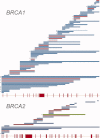Clinical significance of large rearrangements in BRCA1 and BRCA2
- PMID: 22544547
- PMCID: PMC3532625
- DOI: 10.1002/cncr.27556
Clinical significance of large rearrangements in BRCA1 and BRCA2
Abstract
Background: Current estimates of the contribution of large rearrangement (LR) mutations in the BRCA1 (breast cancer 1, early onset) and BRCA2 (breast cancer 2, early onset) genes responsible for hereditary breast and ovarian cancer are based on limited studies of relatively homogeneous patient populations. The prevalence of BRCA1/2 LRs was investigated in 48,456 patients with diverse clinical histories and ancestries, referred for clinical molecular testing for suspicion of hereditary breast and ovarian cancer.
Methods: Sanger sequencing analysis was performed for BRCA1/2 and LR testing for deletions and duplications using a quantitative multiplex polymerase chain reaction assay. Prevalence data were analyzed for patients from different risk and ethnic groups between July 2007 and April 2011. Patients were designated as "high-risk" if their clinical history predicted a high prior probability, wherein LR testing was performed automatically in conjunction with sequencing. "Elective" patients did not meet the high-risk criteria, but underwent LR testing as ordered by the referring health care provider.
Results: Overall BRCA1/2 mutation prevalence among high-risk patients was 23.8% versus 8.2% for the elective group. The mutation profile for high-risk patients was 90.1% sequencing mutations versus 9.9% LRs, and for elective patients, 94.1% sequencing versus 5.9% LRs. This difference may reflect the bias in high-risk patients to carry mutations in BRCA1, which has a higher penetrance and frequency of LRs compared with BRCA2. There were significant differences in the prevalence and types of LRs in patients of different ancestries. LR mutations were significantly more common in Latin American/Caribbean patients.
Conclusions: Comprehensive LR testing in conjunction with full gene sequencing is an appropriate strategy for clinical BRCA1/2 analysis.
Copyright © 2012 American Cancer Society.
Figures

References
-
- Ford D, Easton DF, Bishop DT, Narod SA, Goldgar DE. Risks of cancer in BRCA1-mutation carriers. Breast Cancer Linkage Consortium. Lancet. 1994;343:692–695. - PubMed
-
- Liede A, Karlan BY, Narod SA. Cancer risks for male carriers of germline mutations in BRCA1 or BRCA2: a review of the literature. J Clin Oncol. 2004;22:735–742. - PubMed
-
- Antoniou AC, Gayther SA, Stratton JF, Ponder BA, Easton DF. Risk models for familial ovarian and breast cancer. Genet Epidemiol. 2000;18:173–190. - PubMed
Publication types
MeSH terms
LinkOut - more resources
Full Text Sources
Other Literature Sources
Medical
Miscellaneous

